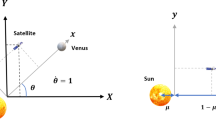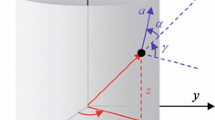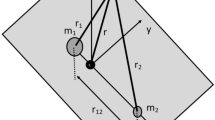Abstract
Venus is Earth’s closest neighbor, hosting a similar size, density, and location in the Solar System. Due to these similarities, Venus has been suggested as a premier location for particular mission sets to include: near-Venus communications and positioning, navigation, and timing (PNT); planetary science; heliophysics; space weather monitoring; and planetary defense. This paper, for the first time in literature, presents 37 unique planar periodic orbits discovered in the Sun–Venus system that may be used for such missions. The Circular Restricted Three-Body Problem (CR3BP) is the primary dynamical model utilized to generate all periodic orbits in the Sun–Venus system. The discovered orbits are grouped into four categories based on their shape: Near-Venus periodic orbits, Sun–Venus touring periodic orbits, Sun–Venus touring periodic orbits featuring near-Sun flybys, and Sun–Venus touring periodic orbits featuring near-Mercury flybys. Each orbit is discussed in terms of its respective Jacobi constant and stability within the context of the CR3BP. The stability of the orbits provides a preliminary analysis of station-keeping costs related to propellant expenditure, thereby determining the feasibility of implementing these trajectories. Specifically, this research shows that most of the identified orbits possess stability indices below 2, suggesting that minimal propellant is necessary for station-keeping maneuvers to sustain the preferred trajectory. For all orbits, specific initial position and velocity states conditions are provided, accompanied by recommendations for their potential mission applications. This research aims to advance ongoing astrodynamics research by filling a catalog hole and providing a Sun–Venus CR3BP orbit baseline.







Similar content being viewed by others
Data availability
The datasets generated for the current study are available following the submission and approval of a formal institutional request to the Air Force Institute of Technology (AFIT).
Notes
There are an infinite number of possible trajectories within the CR3BP. The term “discovered” refers to the generation of a subset of possible orbits within the CR3BP that have not been previously published.
References
Arrhenius, S.: The Destinies of Stars. (1918)
O’Rourke, J., Treiman, A., Arney, G., Byrne, P., Carter, L., Dyar, D., Head III, J., Gray, C., Kane, S., Kiefer, W., et al.: Venus Goals, Objectives, and Investigations. Technical report (2019)
Zasova, L., Gregg, T., Burdanov, A., Economou, T., Eismont, N., Gerasimov, M., Gorinov, D., Hall, J., Ignatiev, N., Ivanov, M., Jessup, L.K., Khatuntsev, I., Korablev, O., Kremic, T., Limaye, S., Lomakin, I., artynov, A., Ocampo, A., Shuvalov, S., Vaisberg, O., Voron, V., Voronstsov, V.: Venera-D: Expanding Our Horizon of Terrestrial Planet Climate and Geology through the Comprehensive Exploration of Venus. EPSC-DPS Joint Meeting (2019)
Ticku, N.J.: Russia Suspends Pact with NASA on Venera-D Venus Exploration Mission Amid New U.S. Sanctions: ROSCOMOS. https://eurasiantimes.com/russia-suspends-cooperation-with-nasa-on-venus-exploration/. [Online; accessed 11 Jul 2023] (2022)
Vaquero, M., Senent, J.: Poincaré: A Multi-Body, Multi-System Trajectory Design Tool. JPL Open Repository (2018). 2014/48975. https://hdl.handle.net/2014/48975
(JPL), J.P.L.: Three-Body Periodic Orbits Database. Jet Propulsion Laboratory (JPL). https://ssd.jpl.nasa.gov/tools/periodic_orbits.html
Restrepo, R.L., Russell, R.P.: A database of planar axisymmetric periodic orbits for the solar system. Celest. Mech. Dyn. Astron. 130, 1–24 (2018)
Restrepo, R., Russell, R.: Periodic Orbit Database. The University of Texas at Austin (2021). https://utexas.app.box.com/v/solarSystemPOdatabase
Dobrovolskis, A.R., Alvarellos, J.L.: Synchronous satellites of venus. Adv. Space Res. 69(1), 554–569 (2022)
Rawal, J.: Possible satellites of mercury and venus. Earth Moon Planet. 36(2), 135–138 (1986)
Anderson, P., Macdonald, M., Yen, C.-W.: Novel orbits of mercury, venus and mars enabled using low-thrust propulsion. Acta Astron. 94(2), 634–645 (2014)
Shirobokov, M., Trofimov, S., Ovchinnikov, M.: On the design of a space telescope orbit around the Sun–Venus \(L_2\) point. Adv. Space Res. 65(6), 1591–1606 (2020)
Zhou, X., Li, X., Huo, Z., Meng, L., Huang, J.: Near-earth asteroid surveillance constellation in the Sun–Venus three-body system. Space Sci. Technol. 2022 (2022)
Young, A.: Eclipses and the Moon’s Orbit. https://eclipse.gsfc.nasa.gov/SEhelp/moonorbit.html#:~:text=The%20Moon%20revolves%20around%20Earth,to%20405%2C504%20km%20at%20apogee [Online; accessed 13 Jan 2023] (2012)
Williams, D.: Venus Fact Sheet. https://nssdc.gsfc.nasa.gov/planetary/factsheet/venusfact.html. [Online; accessed 13 Jan 2023] (2021)
Liou, J.-C., Zook, H.A., Jackson, A.: Radiation pressure, poynting-robertson drag, and solar wind drag in the restricted three-body problem. Icarus 116(1), 186–201 (1995)
Jain, M., Aggarwal, R., et al.: Restricted three body problem with stokes drag effect. Int. J. Astron. Astrophys. 5(02), 95 (2015)
Vincent, A.E., Perdiou, A.E.: Existence and stability of equilibrium points under the influence of poynting–robertson and stokes drags in the restricted three-body problem. In: Mathematical Analysis in Interdisciplinary Research, pp. 987–1002. (2022)
Szebehely, V.: Theory of Orbits. Academic Press, Cambridge (1967)
Howell, K.C., Pernicka, H.J.: Numerical determination of lissajous trajectories in the restricted three-body problem. Celest. Mech. 41(1–4), 107–124 (1987)
Barrabés, E., Mikkola, S.: Families of periodic horseshoe orbits in the restricted three-body problem. Astron. Astrophys. 432(3), 1115–1129 (2005)
Singh, J., Mrumun Begha, J.: Periodic orbits in the generalized perturbed restricted three-body problem. Astrophys. Space Sci. 332, 319–324 (2011)
Vaquero, M., Howell, K.C.: Leveraging resonant-orbit manifolds to design transfers between libration-point orbits. J. Guid. Control. Dyn. 37(4), 1143–1157 (2014)
Smith, T.R., Bosanac, N.: Constructing motion primitive sets to summarize periodic orbit families and hyperbolic invariant manifolds in a multi-body system. Celest. Mech. Dyn. Astron. 134(1), 7 (2022)
Grebow, D.J., Ozimek, M.T., Howell, K.C., Folta, D.C.: Multibody orbit architectures for lunar south pole coverage. J. Spacecr. Rocket. 45(2), 344–358 (2008)
Parker, J.S., Anderson, R.L.: Low-Energy Lunar Trajectory Design, The Deep-Space Communications and Navigation Systems Center of Excellence. Wiley, Hoboken (2014)
Hoelker, R.F.: Nomology of Earth-Moon Orbits, C=4.00 and C=C(L1). NASA Technical Note (1970)
Baltagiannis, A., Papadakis, K.: Periodic solutions in the Sun–Jupiter–trojan asteroid-spacecraft system. Planet. Space Sci. 75, 148–157 (2013)
Wiesel, W.E.: Spaceflight Dynamics, 3rd edn. Aphelion Press, Beavercreek (2010)
Doedel, E.J., Romanov, V.A., Paffenroth, R.C., Keller, H.B., Dichmann, D.J., Galán-Vioque, J., Vanderbauwhede, A.: Elemental periodic orbits associated with the libration points in the circular restricted 3-body problem. Int. J. Bifurcat. Chaos 17(08), 2625–2677 (2007)
Boudad, K.K.: Disposal Dynamics from the Vicinity of Near Rectilinear Halo Orbits in the Earth-Moon-Sun System. Master’s thesis, Purdue University (2018)
Liu, C., Dong, L.: Stabilization of lagrange points in circular restricted three-body problem: a port-hamiltonian approach. Phys. Lett. Sect. A Gener. Atom. Solid State Phys. 383, 1907–1914 (2019). https://doi.org/10.1016/j.physleta.2019.03.033
Meirovitch, L.: Methods of Analytical Dynamics. 1st edn. (2003)
Koon, W.S., Lo, M.W., Marsden, J.E., Ross, S.D.: 2. Dynamical Systems, the Three-Body Problem, and Space Mission Design, 3rd edn. (2011)
Connor Howell, K.: Three-dimensional, periodic,‘Halo’ orbits. Celest. Mech. 32(1), 53–71 (1984)
Li, X., Qian, Y.-J., Yang, X.-D., Zhang, W.: Stability and bifurcation analyses for exterior resonant families in Earth–Moon system. Results Phys. 31, 104961 (2021)
Yousuf, S., Kishor, R.: Families of periodic orbits about Lagrangian Points L1, L2 and L3 with continuation method. Planet. Space Sci. 217, 105491 (2022)
Grebow, D.J.: Generating Periodic Orbits in the Circular Restricted Three-Body Problem With Applications to Lunar South Pole Coverage. Master’s thesis, Purdue University (2006). https://engineering.purdue.edu/people/kathleen.howell.1/Publications/masters/2006_Grebow.pdf
Tancredi, G.: Chaotic dynamics of planet-encountering bodies. Celest. Mech. Dyn. Astron. 70, 181–200 (1998)
Newton, R.R.: Periodic orbits of a planetoid passing close to two gravitating masses. Smithsonian Contrib. Astrophys. 3(7) (1959)
Wilmer, A.P., Bettinger, R.A., Little, B.D.: Cislunar periodic orbits for earth–moon L1 and L2 lagrange point surveillance. J. Spacecr. Rocket. 59(6), 1809–1820 (2022)
Wilmer, A.P.: Space Domain Awareness Assessment of Cislunar Periodic Orbits for Lagrange Point Surveillance. Master’s thesis, Air Force Institute of Technology (2021)
Wishnek, S., Wysack, J., Correa, J.: Eclipse-Free Three-Body Periodic Orbits in Cislunar Space (2022)
Elshaboury, S., Abouelmagd, E.I., Kalantonis, V., Perdios, E.: The planar restricted three-body problem when both primaries are triaxial rigid bodies: equilibrium points and periodic Rrbits. Astrophys. Space Sci. 361, 1–18 (2016)
Elshaboury, S.M., Abouelmagd, E.I., Kalantonis, V.S., Perdios, E.A.: The planar restricted three-body problem when both primaries are triaxial rigid bodies: equilibrium points and periodic orbits. Astrophys. Space Sci. 361, 1–18 (2016)
Bonasera, S., Bosanac, N.: Applying Data mining techniques to higher-dimensional poincaré maps in the circular restricted three-body problem. Celest. Mech. Dyn. Astron. 133, 51 (2021)
Tricoche, X., Schlei, W., Howell, K.C.: Extraction and visualization of Poincaré map topology for spacecraft trajectory design. IEEE Trans. Vis. Comput. Gr. 27, 765–774 (2021)
Russell, R.P.: Global search for planar and three-dimensional periodic orbits near Europa. J. Astronaut. Sci. 54(2), 199–226 (2006)
Franz, C.J., Russell, R.P.: Database of planar and three-dimensional periodic orbits and families near the moon. J. Astronaut. Sci. 69(6), 1573–1612 (2022)
Schlei, W.R.: An Application of Visual Analytics to Spacecraft Trajectory Design. Master’s thesis, Purdue University (2011)
Schlei, W.R.: Interactive Spacecraft Trajectory Design Strategies Featuring Poincaré Map Topology. PhD thesis, Purdue University (2017)
Maruskin, J.M.: Dynamical Systems and Geometric Mechanics, 2nd edn. Walter de Gruyter GmbH, Berlin/Boston (2018)
Roleda, R.C.: Synodic periods of moons and planets. Manila J. Sci. 1(2), 1–1 (1998)
Yin, Y., Wang, M., Shi, Y., Zhang, H.: Midcourse correction of earth–moon distant retrograde orbit transfer trajectories based on high-order state transition tensors. Astrodynamics (2023)
Gupta, M., Howell, K.C., Frueh, C.: Earth–moon multi-body orbits to facilitate cislunar surveillance activities. In: AIAA/AAS Astrodynamics Specialist Conference, pp. 17–18. (2021)
NASA: Parker Solar Probe: Humanity’s First Visit to a Star. https://www.nasa.gov/content/goddard/parker-solar-probe-humanity-s-first-visit-to-a-star. [Online; accessed 4 Dec 2022] (2022)
Huihui, W., Xingqun, Z., Yanhua, Z.: Geometric dilution of precision for GPS single-point positioning based on four satellites. J. Syst. Eng. Electron. 19(5), 1058–1063 (2008)
NASA: Mariner 2. https://solarsystem.nasa.gov/missions/mariner-02/in-depth/. [Online; accessed 4 Dec 2022] (2022)
Kovalenko, I.D., Eismont, N.A., Limaye, S.S., Zasova, L.V., Gorinov, D.A., Simonov, A.V.: Micro-spacecraft in Sun–Venus lagrange point orbit for the venera-D mission. Adv. Space Res. 66(1), 21–28 (2020)
Limaye, S.S., Kovalenko, I.D.: Monitoring venus and communications relay from lagrange points. Planet. Space Sci. 179, 104710 (2019)
McGouldrick, K., Arney, G., Brecht, A., Colaprete, A., Curry, S., Deighan, J., Fukuhara, T., Gray, C., Lillis, R., Navarro, T.: Venus Orbital Mission Concept:Kythiran Eolian dYnamics from the Surface to the Thermosphere from an Orbital NEtwork (KEYSTONE). Technical Report 4 (2021)
Arney, D.C., Jones, C.A.: high altitude venus operational concept (HAVOC): an exploration strategy for venus. In: AIAA Space 2015 Conference and Exposition, p. 4612. (2015)
NASA: MESSENGER. https://solarsystem.nasa.gov/missions/messenger/in-depth/#:~:text=What%20was%20MESSENGER%3F,deposits%20are%20dominantly%20water%2Dice [Online; accessed 20 Nov 2022] (2022)
NOAASatellites: 5 Things: Space Weather. https://www.youtube.com/watch?v=HrloxznL93s &ab_channel=NOAASatellites. [Online; accessed 27 Jul 2023] (2021)
Corporation, B.B.: SpaceX Loses 40 Satellites to Geomagnetic Storm a Day After Launch. https://www.bbc.com/news/world-60317806. [Online; accessed 27 Jul 2023] (2022)
Davis, P., Carney, S.: ACE. https://solarsystem.nasa.gov/missions/ace/in-depth/. [Online; accessed 27 Jul 2023] (2023)
Davis, P., Carney, S.: DSCOVR. https://solarsystem.nasa.gov/missions/DSCOVR/in-depth/. [Online; accessed 27 Jul 2023] (2023)
NASA, NOAA: GOES: Mission Overview. https://www.goes-r.gov/mission/mission.html. [Online; accessed 27 Jul 2023]
Pesnell, D.: About the SDO Mission. https://sdo.gsfc.nasa.gov/mission/#:~:text=About%20The%20SDO%20Mission &text=SDO%20is%20designed%20to%20help,and%20in%20many%20wavelengths%20simultaneously [Online; accessed 27 Jul 2023]
Fleck, B.: About the SOHO Mission. https://soho.nascom.nasa.gov/about/about.html. [Online; accessed 27 Jul 2023] (2020)
Davis, P., Carney, S.: STEREO A & B. https://solarsystem.nasa.gov/missions/stereo/in-depth/. [Online; accessed 27 Jul 2023] (2019)
Zel, H.: Van Allen Probes Mission Overview. https://www.nasa.gov/mission_pages/rbsp/mission/index.html. [Online; accessed 27 Jul 2023] (2020)
Brazo, M.W., Austin, S.A.: The Tunguska Explosion of 1908. https://www.icr.org/research/index/researchp_sa_r05/. [Online; accessed 12 Jan 2023] (1982)
NASA: Double Asteroid Redirection Test (DART). https://solarsystem.nasa.gov/missions/dart/in-depth/. [Online; accessed 12 Jan 2023] (2022)
Koplow, D.A.: Exoatmospheric plowshares. UCLA J. Int. Law For. Aff. 23(1), 76–158 (2019)
NASA: Planetary Defense Coordination Office. https://www.nasa.gov/specials/pdco/index.html
Dunham, D.W., Genova, A.: Using venus for locating space observatories to discover potentially hazardous asteroids. Cosm. Res. 48, 424–429 (2010)
Funding
The authors declare that no funds, grants, or other support were received during the preparation of this manuscript .
Author information
Authors and Affiliations
Corresponding author
Additional information
Publisher's Note
Springer Nature remains neutral with regard to jurisdictional claims in published maps and institutional affiliations.
Rights and permissions
Springer Nature or its licensor (e.g. a society or other partner) holds exclusive rights to this article under a publishing agreement with the author(s) or other rightsholder(s); author self-archiving of the accepted manuscript version of this article is solely governed by the terms of such publishing agreement and applicable law.
About this article
Cite this article
Wilmer, A.P., Bettinger, R.A., Holzinger, M.J. et al. Sun–Venus CR3BP, part 1: periodic orbit generation, stability, and mission investigation. Arch Appl Mech 94, 921–941 (2024). https://doi.org/10.1007/s00419-024-02556-y
Received:
Accepted:
Published:
Issue Date:
DOI: https://doi.org/10.1007/s00419-024-02556-y




